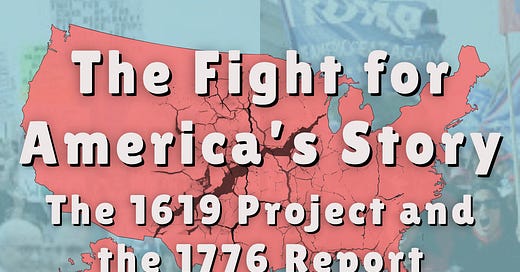The Fight for America’s Story: The 1619 Project and the 1776 Report
How competing visions of patriotism are redefining history education.
In August 2019, The New York Times Magazine launched the 1619 Project to mark the 400th anniversary of the arrival of enslaved Africans in Virginia. Conceived by journalist Nikole Hannah-Jones and a team of writers, historians, and artists, the project’s goal was to reframe American history by treating the year 1619 as the nation’s foundational date, centering the legacy of slavery and the contributions of Black Americans in the national narrative. Jake Silverstein, the magazine’s editor, explained that this “requires us to place the consequences of slavery and the contributions of black Americans at the very center of the story we tell ourselves about who we are as a country.”
The 1619 Project unfolded as a special issue of the magazine, accompanied by essays, poems, fiction, a timeline of African-American history, podcasts, and an interactive website.
The New York Times reported extraordinary public interest upon its release. People lined up to grab copies of the issue and the project earned critical acclaim - including a Pulitzer Prize for Hannah-Jones’s opening essay.
The 1619 Project quickly moved from the pages of a magazine into American classrooms, as educators were quick to notice its potential as a teaching tool. The Pulitzer Center (a nonprofit education organization, unaffiliated with the Prize) partnered with The New York Times to develop curriculum materials and lesson plans based on 1619 Project content.
Within months, thousands of classrooms had incorporated 1619 Project essays into instruction. By the Pulitzer Center’s count, more than 3,500 classrooms used its 1619 Project lesson plans in the first six months. Teachers reported using Hannah-Jones’s essay and related articles on topics like medicine and mass incarceration to enrich U.S. history classes, prompting students to explore how the legacy of slavery influences present-day American life.
And Trump completely lost his mind.
The Background
Just one month after its release, Trump delivered a scathing address to educators and officials, casting the 1619 Project as the centerpiece in what he considered a crisis in America’s classrooms..
“The left has warped, distorted, and defiled the American story with deceptions, falsehoods, and lies. There is no better example than the New York Times’ totally discredited 1619 Project. This project rewrites American history to teach our children that we were founded on the principle of oppression, not freedom.”
He denounced such curricula as Marxist indoctrination and even claimed teaching about systemic racism amounted to “a form of child abuse,” warning that these narratives would “destroy our country.”
Then came the dramatic cliffhanger:
“Today, I’m also pleased to announce that I will soon sign an executive order establishing a national commission to promote patriotic education. It will be called the 1776 Commission.”
He pitched the Commission as the patriotic corrective to the 1619 Project - a way to recenter school curriculum around 1776, the Declaration of Independence, and the Founding Fathers. Trump wanted to stomp out any framing of U.S. history that threatened America’s so-called “gReAtNeSs.”




